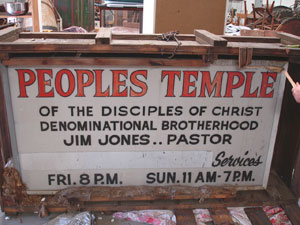 Last month, a piece of Peoples Temple history was auctioned off on the popular auction site eBay. The item: the Peoples Temple sign that hung on the Geary Street building. The final selling price was $3550, fairly low for a one-of-a-kind item, in this author’s opinion.
Last month, a piece of Peoples Temple history was auctioned off on the popular auction site eBay. The item: the Peoples Temple sign that hung on the Geary Street building. The final selling price was $3550, fairly low for a one-of-a-kind item, in this author’s opinion.
During the auction, I was lucky enough to be in contact with the seller, who set up the auction on behalf of the actual owner. I followed the seven-day auction through to the end. By then I had a list of questions I thought needed to be answered. Unfortunately, everyone involved, with the exception of the seller, wanted to remain anonymous and declined my requests to open a dialogue. As a result, there are still missing pieces to the “story of the sign.”
Here’s what I found out. At some point after the dismantling of the Peoples Temple, the sign was – obviously – preserved, but by whom is unknown. Nor can I say where it went right after it was unbolted from the brickface. Clearly, though, someone had the foresight to keep it out of the local landfill. Some years back the sign was pulled out of a storage unit and sold. I tried contacting the person who bought it, but they chose to remain anonymous and not answer questions. That person in turn sold it to an auction house, which also chose to remain anonymous and not answer questions. The gentleman who owns the auction house wanted to sell the sign, but did not want his business connected with the sale, so he asked a friend to put it on eBay for him. The sign did sell, but the same story holds: the new owner wants to remain anonymous. All I know is that the new owner is female and lives in Washington State. Why she bought it and what she plans to do with it are a mystery to everyone except her.
To say that there is a fair amount of stigma attached to the sign is an understatement. No one wants to talk, perhaps out of embarrassment, perhaps out of fear. In either case, the question remains: If these people are so darned uncomfortable, why did they ever bother messing with the sign in the first place? With the possible exception of the current owner, I think the answer lies in the dark folds of a wallet.
The anonymity that people fiercely cling to is yet another example of how Temple “artifacts” are viewed and treated. It is my opinion that a certain segment of the population views Temple ephemera as either a profit-making tool or collectable murder-abilia. They either want it so they can re-sell it and turn a tasty dollar, or they want it for the shock value. In the first case, I find the practice shaky at best, but this is a free country and people are going to do whatever they want with property they own. In the latter case, I find the practice abhorrent and sickening.
What should be done with these artifacts? Should they all be rounded up and tucked away in a museum somewhere? Should everything be preserved? Or should it all be ignored? Perhaps there is no one blanket rule here. But when an exceptional item of real significance is found in the market place, what then? It would be nice if someone with money and a streak of quasi-philanthropy could buy this and donate it to one of the various Temple collections, but this is hardly plausible. As such, the buying and selling of Temple “artifacts” will continue for a long time.
(Josef Dieckman has written extensively about both the “Death Tape” (Q 042) and the “day after” tape (Q 875). His complete collection of writings for the jonestown report may be found here. He can be reached at josefdieckman@yahoo.com.)